Recent Storm Damage Posts
Battling Storm Weather in South Cabarrus County: How SERVPRO® Can Help
5/22/2024 (Permalink)
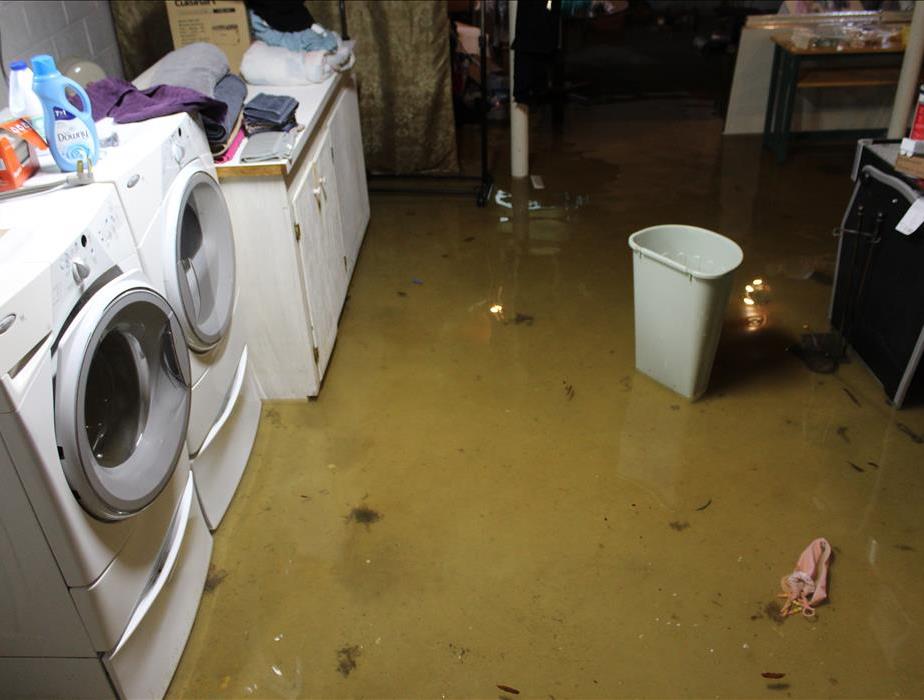 A flooded basement from a recent storm in South Cabarrus County.
A flooded basement from a recent storm in South Cabarrus County.
South Cabarrus County, known for its vibrant communities and picturesque landscapes, is not immune to the unpredictable wrath of Mother Nature. Storm weather, ranging from intense thunderstorms to heavy rains and even the occasional tornado, can wreak havoc on homes and businesses. When the skies turn dark and the winds pick up, residents need to be prepared for the worst. Thankfully, SERVPRO® is here to help restore peace and normalcy after the storm.
Storm weather in South Cabarrus County can lead to a variety of damages:
- Flooding: Heavy rains can cause rivers and streams to overflow, leading to significant flooding in low-lying areas.
- Wind Damage: High winds can tear off roofs, break windows, and uproot trees, causing structural damage to buildings and homes.
- Lightning Strikes: Lightning can cause fires and power outages, further complicating the aftermath of a storm.
- Debris: Storms can scatter debris, making roads impassable and causing additional hazards.
The aftermath of such weather can be overwhelming, leaving homeowners and business owners wondering where to start. This is where SERVPRO steps in.
SERVPRO, a leader in storm damage restoration, provides comprehensive services to help South Cabarrus County residents recover from the devastation caused by storms. Time is of the essence when dealing with storm damage. SERVPRO’s teams are on standby 24/7 to respond to emergencies. Their immediate response ensures that damage is assessed quickly, and an action plan is put into place to mitigate further destruction. Flooding and water intrusion are common issues after a storm. SERVPRO utilizes advanced water extraction equipment and industrial-grade dehumidifiers to remove water and thoroughly dry affected areas. This helps prevent mold growth and structural damage. Storms can leave behind a trail of debris, including fallen trees, shattered glass, and other hazardous materials. SERVPRO’s team efficiently handles debris removal, ensuring that properties are safe and accessible. From minor repairs to major reconstruction, SERVPRO’s skilled technicians are equipped to handle all aspects of structural restoration. They work diligently to repair roofs, walls, windows, and other damaged components, restoring your property to its pre-storm condition. Navigating insurance claims can be a daunting task after a storm. SERVPRO works closely with insurance companies, providing detailed documentation and helping to expedite the claims process. This support can alleviate some of the stress during an already challenging time.
Storm weather can be devastating, but with the right support, recovery is possible. SERVPRO of South Cabarrus County stands ready to help residents and business owners navigate the aftermath of a storm. Their comprehensive restoration services, combined with a commitment to customer satisfaction, make them a trusted partner in times of need. When the storm passes, SERVPRO is there to restore your property and peace of mind.
For more information or to request immediate assistance, contact SERVPRO of South Cabarrus County today. Let them help you weather the storm and come out stronger on the other side.
Cabarrus County Tornado Risk
1/11/2022 (Permalink)
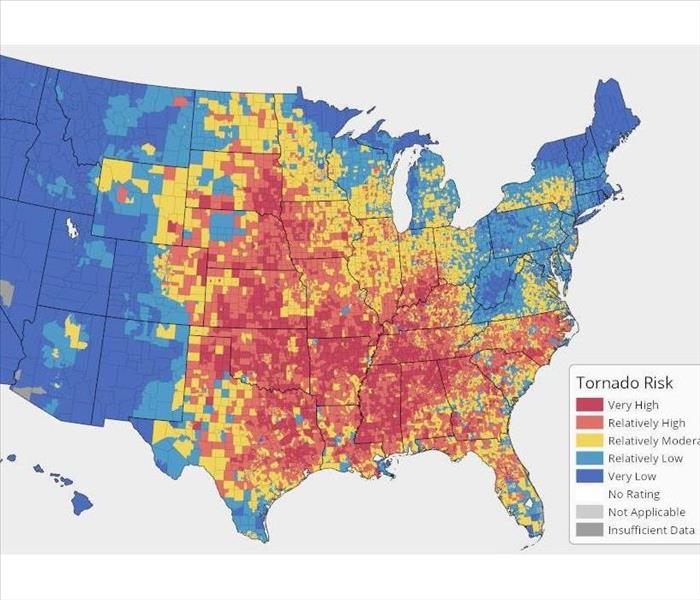 The irony of the century: The blue people feel the least blue
The irony of the century: The blue people feel the least blue
Tornadoes don’t normally hit us this time of year. Kentucky had a wild one back in December, but here in North Carolina, we usually don’t get hit by them in January or February. That being said, it’s not unheard of, and it’s best to know what your risk is in Cabarrus County!
Luckily, FEMA has put together a map of Tornado Risk by county, so you can follow this link to find the map: https://hazards.fema.gov/nri/tornado.
I’ve also popped the map into the top of this article, so you can take a quick peek at that picture and see what shade your county is. It’s not horrendous here, but it’s also not great. We’re somewhere between Oklahoma and Alaska in Tornado damage risk. The good news is we’re fairly safe from avalanches and tsunamis!
If you have Winter Storm Damage, you need SERVPRO of South Cabarrus County!
1/11/2022 (Permalink)
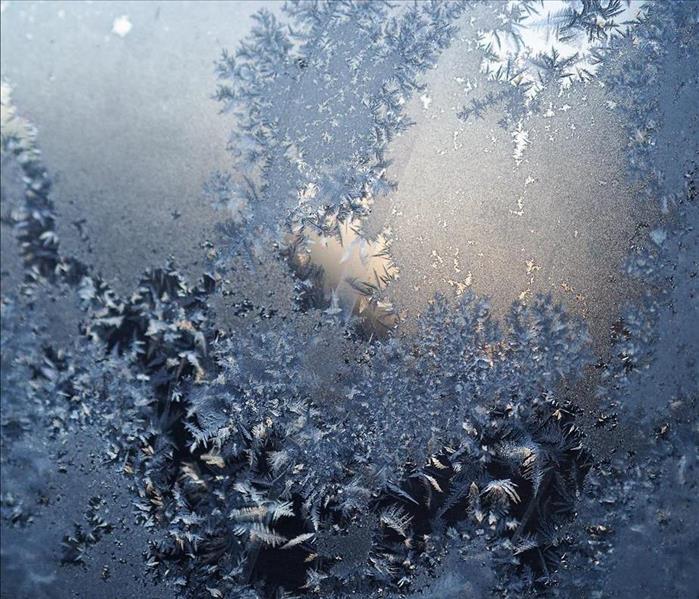 It's so pretty... pretty and destructive!
It's so pretty... pretty and destructive!
Winter Storm Damage can range from frozen windows breaking to heavy sleet damaging a roof to trees collapsing under the weight of ice or snow and breaking your precious belongings. No matter what the winter storm damage may be, SERVPRO of South Cabarrus is experienced and equipped to handle the restoration job. We have years of work to back up these claims, and collectively have decades of work history in cleanup and restoration for all sorts of damage, especially winter storm damage, which will likely be our bread and butter for the next few weeks. If you find yourself in the shoes of someone who needs some help cleaning and restoring your home after a winter storm, you need SERVPRO! Call us immediately and we can be there in less than four hours (our average is closer to three!).
Rapid Cold is Coming this Weekend–What’s your Risk?
1/11/2022 (Permalink)
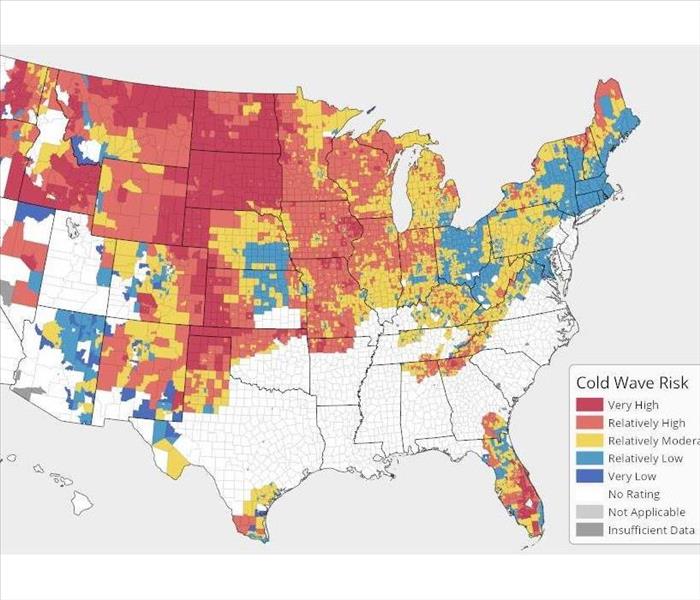 Grey is anything but dull--it means you can breathe a sigh of relief!
Grey is anything but dull--it means you can breathe a sigh of relief!
Rapid Cold can be catastrophic for your health and safety and well-being, and it’s tough to adapt when you don’t know what your risk is! However, you’re not helpless and without a clue thanks to FEMA’s Rapid Cold map: https://hazards.fema.gov/nri/cold-wave
As you can see, most sections of North Carolina are safe from a serious cold wave, although Virginia is supposedly fine as well and we saw how well that worked out for them a few weeks ago.
Nevertheless, cold waves are in season and can happen with little warning. It’s important to pay attention to the weather as you will generally have only a day or two to change plans, avoid travel, and stock up on supplies for the coming cold wave so you stand a better chance of making it through in one piece!
Ice Storms are Coming this Weekend–What’s your Risk?
1/11/2022 (Permalink)
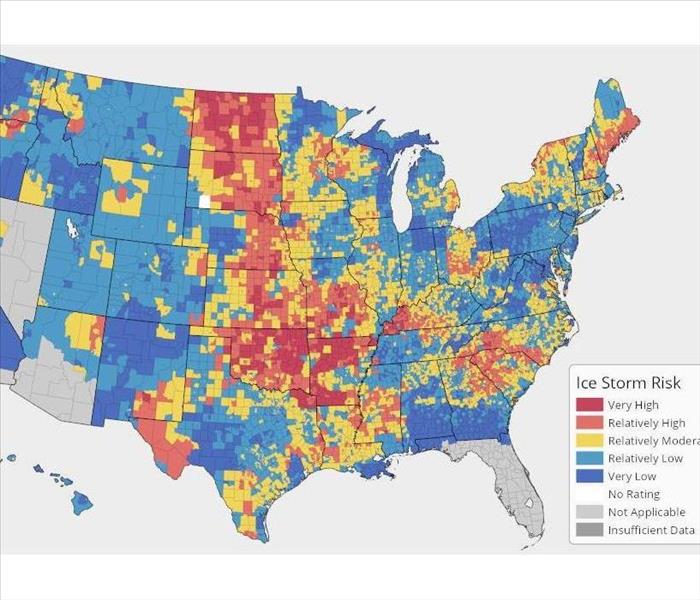 We at SERVPRO prefer to keep the ice in our veins, not in our homes!
We at SERVPRO prefer to keep the ice in our veins, not in our homes!
Ice Storms can be even more dangerous than traditional storms. Sure, there’s less lightning and thunder (although thunder isn’t a big deal if you’re not a baby), but there’s ice, and ice isn’t nice. If you’ve been living in NC for a while, you’ve probably got a pretty good grasp on what your risks are for certain types of weather, but if you’re new, or if it’s a particularly nasty year, it’s best to check things out and be safe rather than sorry! FEMA (The Federal Emergency Management Association) has maps for risk of damage for each type of natural disaster by county, so you can easily find out your risk! Follow the link here: https://hazards.fema.gov/nri/ice-storm, or check out the map image at the top of this article to find out your family’s risk of ice storms!
Cabarrus County Hail Risk
1/11/2022 (Permalink)
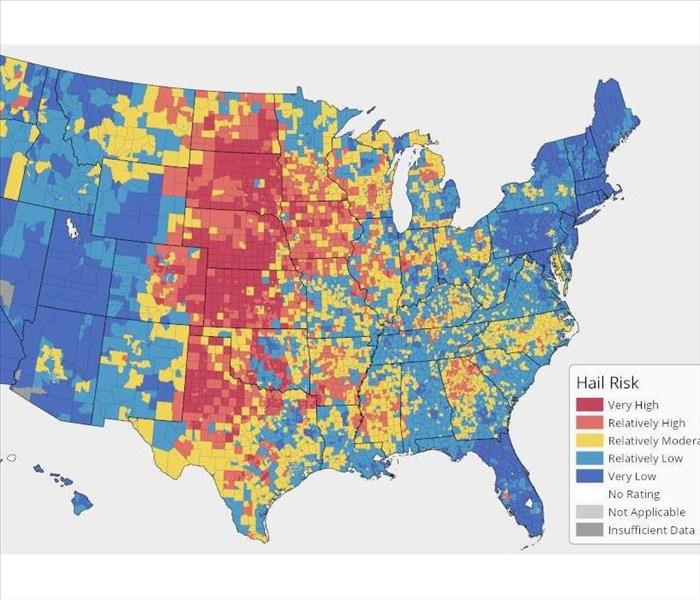 Raising Hail may be alright on occasion, but falling hail is always bad news!
Raising Hail may be alright on occasion, but falling hail is always bad news!
Hail can be a highly destructive form of precipitation for a giant chunk of ice falling 40,000 feet from the top of a cumulonimbus cloud! Also, since it doesn’t have to happen during particularly cold weather (it’s actually more likely in the Summer!), it can happen pretty much anywhere. Very few counties have absolutely no hail risk, and just slightly more have very little hail risk. How do we know? FEMA (The Federal Emergency Management Association) collects data to produce a map of Hail Risk by county, and it can be found here: https://hazards.fema.gov/nri/hail
It can also be found at the top of this blog post in an image header format. Sorry about cropping out the Western half of the US, but if you live out there, you should probably call a SERVPRO that’s a bit closer and won’t be a 60-hour drive away.
What is my Risk for Hail Damage?
11/12/2021 (Permalink)
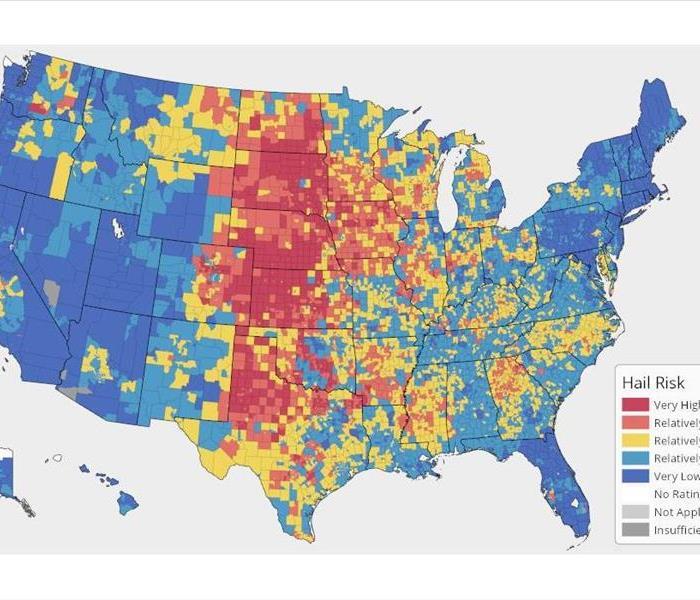 This map shows your risk for loss from Hail. (Note, this is unrelated for your risk of hailing a taxi! That would be red mostly in NYC!)
This map shows your risk for loss from Hail. (Note, this is unrelated for your risk of hailing a taxi! That would be red mostly in NYC!)
Water is a beautiful molecule. It sustains all life on earth, it refreshes, it cleanses, it supports us.
However, when water freezes into a block of ice the size of a softball and falls from the top of a cumulonimbus cloud down on your home, it’s a bit less beautiful.
You might wonder what your risk of hail damage is. There’s not much you can do to stop a block of ice the size of a grapefruit from falling on your house if it decides to fall on your house, but you can at least get an idea of what to expect as far as damages go in your county.
Luckily, our friends at FEMA put together a map showing expected loss for each county in our great nation, and we found it. It’s attached to this post, but you can also see it for yourself here: https://hazards.fema.gov/nri/hail
Thankfully, it doesn’t seem like we in the Cabarrus County area are at too much risk--in fact, we might even be at the lowest risk!
So that’s a bit of some positive news to help you get through your day.
The damage ice dams bring
12/18/2020 (Permalink)
Ice dams can be harmless or cause some serious, secret destruction. The ice that forms at the edge of a roof, blocking water or melted snow from draining, is called an ice dam. When the water doesn't drain, it puts weight on the roof, and because water takes the path of least resistance, it will find an entrance into your home, usually between the shingles. If water enters your home because of an ice dam, it is typically undetectable, allowing mold and mildew to grow behind your walls, in your attic, and on your ceiling. Mold and mildew can cause health effects, so it is imperative to stop the source of loss, dry the moisture, and clean any mold that may have grown. If you discover this has happened to your home this winter, please call us. We can fix any issue that is caused due to moisture issues in your home. We'll make it, "Like it never even happened."
Ice storms - BEWARE!
12/16/2020 (Permalink)
Ice storms can often be one of the most horrific natural weather occurrences. These storms cause a multitude of accidents like car crashes, power outages, and injuries to oneself. When falling snow meets a layer of air that is warm enough to melt the snow, it becomes freezing rain. If you look at a weather map, freezing rain is usually found on the cold side of a warm front. In this area, surface temperatures are typically below freezing or at the freezing point. As the rain falls, it becomes super cold from passing through a layer of cold air, and as it comes in contact with a cold surface, it freezes. The drops themselves do not freeze; however, they become so cold they are referred to as "supercooled drops." When these supercooled drops come in contact with a surface, they freeze instantly and form a thin layer of ice, and this is why it is called freezing rain. Freezing rain can affect any surface. Call SERVPRO of South Cabarrus County for any restoration you need due to melted ice.
Continuing our in-depth look at the dangers of hurricanes
11/17/2020 (Permalink)
Winds of greater than 110 miles per hour are considered to be major hurricanes. In the Gulf of Mexico, the Caribbean Sea, and the Atlantic ocean, ten tropical storms develop every year. Of those ten storms, six become hurricanes. Over the course of three years, roughly five of those hurricanes will hit the U.S. coastline. During these five storms, harsh weather can kill 50 to 100 people in coastal states spanning Texas to Maine. Hurricanes vary in size but are typically around 300 miles wide. The center of a hurricane is referred to as the eye, a relatively calm area that spans between 20 to 40 miles wide. The storm wall surrounding the eye has extremely dense clouds that host the highest winds in the storm. These storms have such forceful winds they create rain bands. Rain bands are thick bands of thunderstorms that can be 50 to 300 miles long and anywhere from a couple of miles to tens of miles wide.
Even storms with winds of 40 miles per hour can be dangerous. It is important to stay safe during a storm and remain indoors if possible. If a storm causes damage to your home, give us a call, and we'll make it, "Like it never even happened."
Recipe for a Hurricane
11/16/2020 (Permalink)
It takes several factors for a hurricane to form in tropical areas.
Most hurricanes start as tropical waves. Tropical waves are most easily defined as an elongated area of relatively low air pressure spanning from north to south moving east to west. Water that is 79 to 80 degrees Fahrenheit with a depth of 164 feet powers the storm. Ocean heat is used by thunderstorms to fuel hurricanes. The storm can weaken depending on any significant differences in wind speed and direction around the storm. When these factors mix together, you may just get a hurricane, but having all of these ingredients doesn’t necessarily mean a hurricane will form. In most cases, an entire hurricane may not develop, but there will still be heavy storms that affect the surrounding areas. If your area has been affected by heavy rain and strong winds, call SERVPRO to make any damage “Like it never even happened.”
Hurricane categories
11/10/2020 (Permalink)
There are five categories for hurricanes. Wind speeds determine what category a storm is. Category one hurricanes have wind speeds of 75 to 95 miles per hour. These wind speeds will cause some damage. The damage to well-built houses will likely be roof damage, damage to the shingles, and vinyl siding and gutters. Trees with shallow roots may be uprooted, and the large branches will snap. Power lines will have extensive damage that may cause power outages that could last up to several days. Category two wind speeds continue at 96 to 110 miles per hour with similar damage to homes as a category one hurricane but more severe. This means damage to roofs and siding will have more damage and snapped or fallen trees will be more likely to block roads. Expect near-total power losses for several days to weeks. A category three hurricane is considered a major storm. The wind speeds reach up to 111 to 129 miles per hour. The damage incurred to a well-structured home will be severe and may even remove an entire roof, decking, and gable ends. Trees will snap or be uprooted and block numerous roads along with power and water outages several days or weeks even after the storm has passed. A category four hurricane’s wind speeds are measured at 130 to 156 miles per hour. A cyclone in this category is considered a significant storm that will incur catastrophic damage. Trees and power poles will be uprooted and isolate many residential areas leaving them with no power or water for weeks. Roofs and exterior walls will be severely damaged, and a majority of the site will be uninhabitable. A category five has wind speeds of 157 miles per hour or faster. A hurricane of this category will cause extreme catastrophic damage. Most homes, well-built or not, will be destroyed with total roof failure and structure collapses. Trees and power poles will be fallen over, blocking roads. There will not be water or electricity for many weeks to months. The area will be considered uninhabitable until the area is cleared and repaired. SERVPRO of South Cabarrus County works diligently to help in such distressing disasters to make it “Like it never even happened.” Our goal is always to help where we are capable.
Prepare for a storm ahead of time.
10/30/2020 (Permalink)
Did you know SERVPRO offers a FREE Emergency Ready Profile App that you can download in the app store today to help you be ready for any type of disaster? The benefit of using the Emergency Ready Plan app is that any member of your team or family can access the information stored there. The app compiles the list of companies you will need in the case of an emergency. When your home or business is flooding due to a storm or busted pipe, the last thing you want to waste your time doing is looking up plumbers and reading reviews while you're standing in a foot worth of water.
With that being said, the CDC states it is Atlantic hurricane season from June 1 through November 30 each year. It is natural for storm disasters to cause stress, anxiety, grief, and loads of worry. This year has been even more chaotic than the last because we have all been affected by the global pandemic, Covid-19. Take the necessary steps now to ensure your safety should a storm hit. Prepare ahead of time by stockpiling all the supplies you will need in an emergency by preparing your emergency food, water, and medical supplies.
Prepare Before a Snowstorm
11/18/2019 (Permalink)
A winter storm can keep you trapped indoors for days without power. How do you prepare for a snowstorm?
Prepare your home for winter before it starts to snow. Keep your family safe and comfortable during a blizzard by having a storm plan.
- If you live in a place where it snows often enough, it is a good idea to invest in a generator. A reliable generator and fuel supply can practically save the day.
- Make a winterized emergency kit. American Red Cross has a guide you can follow.
- Inspect your chimney and have it cleaned before winter.
- Get a weather radio that can use batteries if the power goes out.
- Stock up on batteries.
- Get a sturdy shovel.
- Clean the gutters and ensure that the roof is stable.
- Check the weatherstrips on windows and doors.
- Make sure the walls and attics are insulated.
- Stock up on blankets.
- Make sure you have a fully stocked first-aid kit.
- Learn first-aid for hypothermia and frostbite.
- Make sure you have a fire extinguisher that works.
- Get sand, ice melt, or kitty litter for icy surfaces.
- Winterize your car. Fema.govhas more information on this.
What to do just before a storm:
After the National Weather Service issues a Winter Storm Watch, start taking precautions for a more significant storm.
- You'll need to stock up on fuel for the generator.
- Charge all phones, rechargeable batteries, and power banks.
- Make sure flashlights at the ready.
- Fill your gas tank and have spare gas ready.
- Make sure you have plenty of non-perishable foods and toilet paper.
- Let pets in and bring plants indoors.
- Make sure your stoves are clean and work with no issues.
- Let all faucets drip slowly and insulate exposed pipes with newspapers or other insulation materials.
To-Do Tip for Winter Storms
11/14/2019 (Permalink)
To-Do Checklist (With Electrical Power)
1) If you still have electricity in your home, try to keep your thermostat as high as possible for as long as you can. If you no longer have power in your house try to find a gas-powered heater
2) Unless there is an emergency STAY INSIDE.
3) If you turn all your faucets to a slow drip, it can help prevent your pipes from freezing.
4) Wear dry or waterproof clothes, maybe even a few layers to preserve body heat.
5) Stay hydrated with plenty of fluids. It is recommended that we drink two quarts (64 ounces or about eight glasses) of water each day. Experts also suggest that, in emergencies, you should drink two quarts (half a gallon) of water a day – more if you're in a hot climate, sick, pregnant, or a child
To-Do Checklist (If the Power Goes Out)
1) Use a generator to power "essential devices," like the refrigerator and heaters.
2) Unplug computers and other non-essential electrical equipment to avoid a power surge.
3) To keep food from spoiling, try not to open the freezer or fridge.
4) Move frozen food and things that could go bad quickly to a garage to stay frozen if the power is out for a long time.
5) Use flashlights to avoid the risk of a fire.
6) Try not to use cooking devices that may emit carbon monoxide or other fumes.
7) Try to dress in layers, and use blankets and towels to help keep warm.
8) If you have a weather radio, periodically listen to weather reports for your area.
Damage To Your Home
11/8/2019 (Permalink)
Frozen Pipes
Pipes are more likely to freeze and burst when the temperature is below 20 degrees Fahrenheit. Water can get into cracks and expand when it freezes. This freezing action causes larger cracks and damage. The resulting water damage can be severe. Outdoor pipes and pipes in unheated areas of the home can freeze if they are not insulated or if temperatures are frigid.
Outdoor pipes likely to freeze include:
Outdoor hose
Swimming pool supply lines
Water sprinkler lines
Pipes in unheated or partially heated areas might also freeze, including:
Basements
Crawl spaces
Garages
Ice Dams
An ice dam forms when snow melts unevenly on a roof and refreezes at the edge of the roof, near the eaves. This dam prevents melting snow from draining off the roof. The standing water can back up under shingles, leak into a home, and cause water damage to ceilings, walls, and other areas. Ice dams can also tear off gutters and loosen shingles.
Roof Damage
Snow and ice can cause major damage to your gutters and roof. The additional weight of snow and ice could cause a roof to collapse. When there’s a cold snap, water can get into cracks and small spaces and expand when it freezes, causing larger cracks and more damage. Freezing and melting over and over again can cause small cracks to become more significant.
A Few Ways Winter Storms Damage Homes
11/1/2019 (Permalink)
If you live in an area where temperatures drop quickly in the winter, it is best to educate yourself and be prepared. There are a few ways a snowstorm can affect you listed below.
Ice:
The weight of frozen rain on trees and power lines can have a severe impact. Damage can start with a quarter-inch of accumulation. There can be widespread destruction with power outages lasting for days with thick piles of a half-inch or more.
Wet Snow:
Snow sticks easily to trees and power lines when they're carrying a lot of moisture. Similar to ice accumulation, this adds extra weight and stress, which highers the possibility of damage.
Snow on Roofs:
Snow from multiple storms building up on roofs and can cause the roofs to collapse.
Flooding After the Snow:
Temperatures that rise quickly or heavy rain after a winter storm that had a lot of snowfall can set the stage for significant flooding when it begins melting.
High Winds:
When strong winds can enhance the potential for tree damage and power outages when accompanied by ice and snow. Strong winds from winter storms can also cause power outages and cause tree damage even in areas where there is hardly any snow or ice.






 24/7 Emergency Service
24/7 Emergency Service





